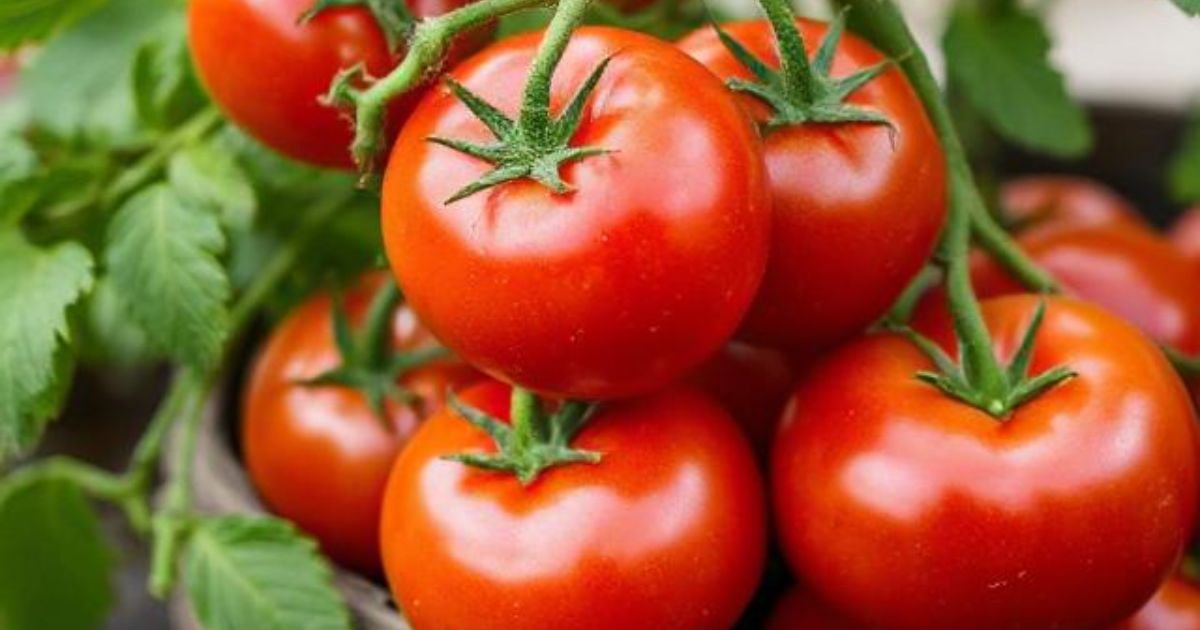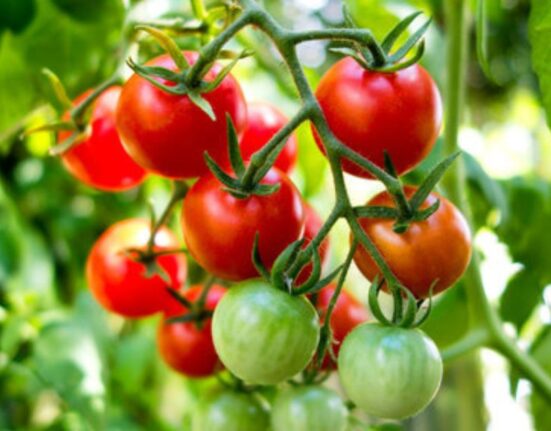One of the most well-liked and fruitful crops to cultivate in any home garden. Whether you’re a seasoned gardener or just getting your hands dirty for the first time, one powerful and natural way to boost your tomato plant’s health and productivity is through companion planting. This time-tested gardening technique involves growing specific plants close to one another to promote growth, keep pests away, and even enhance flavor.
When it comes to tomatoes, particular companions can help deter common pests like aphids and hornworms, while others can enrich the soil or offer natural shade and ground cover. On the flip side, planting incompatible neighbors can stunt growth or attract unwanted pests. Understanding which plants work well with tomatoes—and which ones to avoid—can make a big difference in your harvest. plant flowers with tomatoes In this blog, we’ll explore the best (and worst) companion plants for tomatoes and offer simple tips to help you create a thriving, productive garden naturally.
What Is Companion Gardening?
Companion gardening, also known as Companion planting, is the process of cultivating various plant species following one another for mutual benefit. This method leverages natural relationships between plants to improve growth, enhance flavor, repel pests, and attract beneficial insects. For tomatoes, companion planting can mean healthier plants, fewer pest problems, and tastier fruit—all without relying on synthetic fertilizers or pesticides.
The idea has its origins in conventional farming methods, Tomato Cage Guide: Support For Stronger Plants with Native American “Three Sisters” planting (corn, beans, and squash) being a classic example. When applied to tomatoes, companion gardening creates a balanced garden ecosystem that promotes sustainability and productivity.
Why Companion Planting for Tomatoes?

Tomatoes are a staple in home gardens, prized for their versatility and flavor. However, they’re susceptible to pests like aphids, Whiteflies, hornworms, and illnesses like blight. Companion planting offers a natural solution to these challenges by:
- Repelling Pests: Certain plants emit odors or chemicals that deter common tomato pests.
- Attracting Beneficial Insects: Flowers and herbs can attract pollinators and predatory insects that control pest populations.
- Improving Soil Health: Some companions add nutrients to the soil or prevent erosion.
- Enhancing Flavor: Certain plants may subtly influence the taste of tomatoes.
- Maximizing Space: Companion planting makes efficient use of garden space, especially in small plots.
With these benefits in mind, what to plant with tomatoes let’s dive into the best companion plants for tomatoes and how to incorporate them into your garden.
What Grows Best with Tomatoes
Tomatoes thrive when paired with the right companiontomato plant companion that support their growth, deter pests, and enrich the soil. One of the best-known companions is basil, which not only improves tomato flavor but also keeps pests like whiteflies and aphids away. Marigolds are another top choice, as they emit a strong scent that deters nematodes and a variety of garden pests.Carrots and onions grow well near tomatoes, helping to improve soil structure and reduce insect populations. Garlic and chives are also great companions, as their strong odors discourage spider mites and other unwanted bugs. Lettuce and spinach act as live mulch, which inhibits weed growth and keeps the soil cool and moist.
Borage, a lesser-known but powerful ally, attracts pollinators and beneficial insects while improving tomato plant resilience. Nasturtiums can serve as trap crops by drawing aphids away from tomatoes. companion planting tomatoes Meanwhile, parsley can attract hoverflies and predatory wasps, natural enemies of tomato pests.When planted together strategically, these companions not only support healthier tomato plants but can lead to a more productive and pest-resistant garden overall. Growing with companion plants is simple and organic. Better tomatoes without using harmful chemicals.
Best Companion Plants for Tomatoes
Choosing the proper companions for your tomato plants is key to a successful garden. Below are some of the most effective companion plants, along with their specific benefits.
Basil
Basil is the quintessential tomato companion, and for good reason. This aromatic herb not only enhances, In addition strengthens tomato flavor in the garden and on the plate, companion plants with tomatoes it also keeps pests like mosquitoes, spider mites, and aphids away. Pests find it more difficult to find your tomato plants because of the pungent aroma of basil.
- Benefits: Pest control, improved tomato flavor, and attracts pollinators like bees.
- How to Plant: Place basil plants about 12-18 inches from tomato plants to allow for adequate airflow. Varieties like sweet basil or Genovese basil work well.
- Pro Tip: Pinch back basil regularly to encourage bushy growth and prevent it from overshadowing smaller tomato plants.
Marigolds
Marigolds, particularly French marigolds, are a powerhouse in he garden. Their roots release a chemical that repels soil-dwelling nematodes, which can damage to ato roots. Additionally, marigolds’ bright flowers attract pollinators and beneficial insects like ladybugs, which prey on aphids.
- Benefits: Nematode control, attracts beneficial insects, and adds vibrant color to the garden.
- How to Plant: Plant marigolds around the base of tomato plants or in rows between the tomato beds. Space them about 8-12 inches apart.
- Pro Tip: Deadhead spent marigold flowers to encourage continuous blooming throughout the season.
Nasturtiums
Nasturtiums are a trap crop, meaning they lure pests like aphids and whiteflies away from tomatoes. Their vibrant, edible flowers also attract pollinators and add beauty to he garden. Plus, nasturtiums can act as a ground cover, suppressing weeds and retaining soil moisture.
- Benefits: Trap crop for pests, attracts pollinators, and edible flowers.
- How to Plant: Sow nasturtium seeds around the edges of tomato beds or in containers nearby. They thrive in poor soil, so avoid over-fertilizing.
- Pro Tip: Harvest nasturtium flowers and leaves for salads to add a peppery flavor to your meals.
Garlic
Garlic’s pungent odor is a natural deterrent for pests like spider mites, aphids, and Japanese beetles. Planting garlic near tomatoes can reduce pest pressure and may even help prevent fungal diseases like early blight.
- Benefits: Pest repellent, potential disease prevention.
- How to Plant: In the fall, plant garlic cloves. How To Grow Zinnia Flowers For a summer harvest, space them about 6 inches from tomato plants.
- Pro Tip: Use garlic sprays (made by steeping crushed garlic in water) as an additional pest deterrent.
Borage
Borage is a lesser-known but highly effective companion for tomatoes. Its star-shaped blue flowers attract pollinators like bees, which are essential for tomato fruit set. Borage also repels tomato plants and flowers hornworms and adds trace minerals to the soil as it decomposes.
- Benefits: Attracts pollinators, repels hornworms, improves soil health.
- How to Plant: Sow borage seeds near tomatoes, spacing plants about 12 inches apart. Borage self-seeds, so you may get volunteers next season.
- Pro Tip: Borage leaves and flowers are edible and can be used in teas or salads.
Carrots
Carrots and tomatoes make excellent companions because carrots loosen the soil with their deep roots, improving aeration and drainage for tomato plants. They also grow well in the partial shade provided by taller tomato plants.
- Benefits: Improves soil structure, efficient use of garden space.
- How to Plant: Sow carrot seeds in rows between tomato plants. Choose shorter varieties like ‘Nantes’ to avoid competition for nutrients.
- Pro Tip: Harvest carrots early to prevent them from becoming woody in hot weather.
Onions
Onions, like garlic, emit a strong odor that repels pests such as aphids and flea beetles. They also take up minimal space, making them ideal for interplanting with tomatoes.
- Benefits: Pest repellent, space-efficient.
- How to Plant: Plant onion sets or seedlings about 6 inches from tomato plants, Turning Trash into Treasure ensuring they have enough sunlight.
- Pro Tip: Rotate onions with other companions each season to prevent soil nutrient depletion.
Lettuce
Lettuce is a great companion for tomatoes in small gardens. As a low-growing crop, it thrives in the shade of tomato plants, making efficient use of space. Lettuce also helps retain soil moisture and suppress weeds.
- Benefits: Space-efficient, weed suppression, moisture retention.
- How to Plant: Sow lettuce seeds in rows or clusters around the base of tomato plants. Choose heat-tolerant varieties like ‘Black Seeded Simpson’ for summer planting.
- Pro Tip: Harvest lettuce as baby greens to avoid overcrowding.
Plants to Avoid Planting Near Tomatoes

Not every plant gets along well with tomatoes. Some can compete for nutrients, attract pests, or increase disease risk. Here are plants to avoid:
- Potatoes: Both tomatoes and potatoes are members of the nightshade family and are prone to diseases and pests like l e blight. The danger of disease transmission rises when they are planted together.
- Corn: Corn attracts pests like corn earworms, which also feed on tomatoes (as tomato fruitworms).
- Fennel: Fennel releases chemicals that can inhibit tomato growth and attract pests.
- Cabbage Family (Brassicas): Plants like broccoli, cauliflower, and cabbage compete heavily with tomatoes for nutrients and may stunt their growth.
- Dill: While young dill can benefit tomatoes by attracting beneficial insects, mature dill can inhibit tomato growth and should be kept at a distance.
Practical Tips for Successful Tomato Companion Gardening
To make the most of companion planting, follow these practical tips:
- Plan Your Layout: Before planting, sketch your garden layout to ensure proper spacing and sunlight for all plants. Taller companions like marigolds or borage should be placed where they won’t shade smaller tomato plants.
- Rotate Crops Annually: Rotate tomatoes and their companions each year to prevent soil-borne diseases and nutrient depletion.
- Monitor Soil Health: Use compost or organic fertilizers to maintain soil fertility, as companion plants may compete for nutrients.
- Water Wisely: Tomatoes need consistent moisture, What are the Easiest Most Profitable but some companions (like nasturtiums) prefer drier conditions. Group plants with similar water needs together.
- Observe and Adjust: Every garden is unique. compatible plants with tomatoes Look for indications of stress in your plants or pest issues and adjust your companion pairings as needed.
Sample Tomato Companion Garden Plan

Here’s a sample layout for a 4×8-foot raised garden bed:
- Center Row: Tomato plants (spaced 24 inches apart).
- Edges: Marigolds and nasturtiums (alternating every 12 inches).
- Between Tomatoes: Basil and lettuce (interplanted in clusters).
- Corners: Borage or garlic for pest control and pollinator attraction.
This layout maximizes space, ensures good airflow,plant what with tomatoes and balances pest control with pollinator attraction.
Common Challenges and Solutions
Even with companion planting, challenges can arise. Here’s how to address common issues:
- Overcrowding: Space plants adequately to prevent competition for light and nutrients. Thin seedlings early to avoid overcrowding.
- Pest Outbreaks: If pests persist, introduce beneficial insects like ladybugs or use organic pest controls like neem oil.
- Disease: Avoid overhead watering and make sure there is adequate air circulation to reduce fungal diseases like blight.
- Nutrient Deficiency: Test your soil annually and amend use organic fertilizers or compost to keep nutrient levels stable.
Conclusion
Companion planting is more than just a gardening trend—it’s an innovative, natural strategy that can significantly enhance the well-being and yield of your tomato plants. By surrounding your tomatoes with the right allies like basil, marigolds, or carrots, you can boost growth, ward off harmful pests, What Plant Attracts Hummingbirds and even enhance flavor without relying on chemicals or artificial methods.what can i plant with tomatoes
At the same time, knowing which plants to avoid—like potatoes or fennel—can save your garden from unwanted competition or disease. With a little planning and observation, companion gardening can turn your tomato patch into a thriving, harmonious mini-ecosystem.So, whether you’re planting in pots, raised beds, or a backyard plot, try incorporating some companion plants this season. Your tomatoes will thank you with more vigorous vines, fewer pests, and a more bountiful harvest!
FAQ
1. Can I plant peppers with tomatoes?
Yes, peppers and tomatoes are compatible companions. They share similar growing needs and won’t harm each other. However, keep an eye on pests and diseases, as both plants can be affected by similar problems, like aphids or blight.
2. What herbs are best to grow with tomatoes?
Basil is the most popular herb companion—it repels pests and may improve tomato flavor. Other good choices include parsley, chives, and mint, though mint should be planted in containers to avoid spreading aggressively.
3. Do marigolds really help tomato plants?
Absolutely! Marigolds deter nematodes, aphids, and whiteflies. Their strong scent confuses pests and attracts beneficial insects. Planting marigolds around your tomato bed is a proven organic method for natural pest control.
4. How close should companion plants be to tomatoes?
Companion plants should be placed within 12–24 inches of your tomatoes. Ensure each plant still has enough airflow and light. Proper spacing helps maximize benefits without overcrowding or stressing your tomato plants.
5. Can I grow tomatoes with cucumbers?
Tomatoes and cucumbers can be grown together, but they compete for space and nutrients. Provide trellises and ensure good airflow to reduce the risk of fungal diseases that affect both plants.








